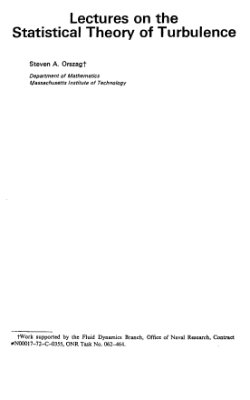Massachusetts Institute of Technology, 1974? 374 p.
1 The Nature of Turbulence
Introduction
Line Stretching by Isotropic Turbulence
Methods of Taking Averages
Finite-Mode Model
Mathematical Theory of the Navier-Stokes Equations
2 The General Theory of Homogeneous Turbulence
The Description of Homogeneous Turbulence
Velocity-Correlation Tensor
Fourier Analysis of the Velocity Field
Dynamical Equations for Cumulants
Energy Balance
The Spectrum of Homogeneous Turbulence
The Structure of the Large Eddies
The Probability Distribution of Velocity
The Decay of Total Energy
The Taylor-Green Vortex
3 Small-Scale Structure of Turbulence
The Equilibrium Range
Comparison with Experiment
Intermittency and Models of Turbulent Motion
Two-Dimensional Homogeneous Turbulence
4Introduction to Analytical Theories of Turbulence
Introduction 2
Models for Energy Transfer
Expansion in Powers of the Reynolds Number
Quasi-Normal Theory: Single-Time Moments
Properties of Wayevector Integrations and Kinematical Coefficients
Properties of the Single-Time Quasi-Normal Theory
Quasi-Normal Theory: Markovian Modification
Semi-Local Inertial-Range Structure
The Test-Field Model
5 The Statistical Mechanics of Turbulence
Introduction 3
Inviscid Equipartition Ensembles
The Fluctuation-Dissipation Theorem
Equilibrium Properties of Cumulant-Discard Closures
Stochastic Relaxation
Mechanisms of Irreversible Relaxation
6 The Direct-Interaction Approximation
Direct-Interaction Approximation
Consistency Properties of the Direct-Interaction Equations
Random Coupling Model
Diagram Methods
Inertial-Range Dynamics of the DIA
Comparison with Experiment
References
1 The Nature of Turbulence
Introduction
Line Stretching by Isotropic Turbulence
Methods of Taking Averages
Finite-Mode Model
Mathematical Theory of the Navier-Stokes Equations
2 The General Theory of Homogeneous Turbulence
The Description of Homogeneous Turbulence
Velocity-Correlation Tensor
Fourier Analysis of the Velocity Field
Dynamical Equations for Cumulants
Energy Balance
The Spectrum of Homogeneous Turbulence
The Structure of the Large Eddies
The Probability Distribution of Velocity
The Decay of Total Energy
The Taylor-Green Vortex
3 Small-Scale Structure of Turbulence
The Equilibrium Range
Comparison with Experiment
Intermittency and Models of Turbulent Motion
Two-Dimensional Homogeneous Turbulence
4Introduction to Analytical Theories of Turbulence
Introduction 2
Models for Energy Transfer
Expansion in Powers of the Reynolds Number
Quasi-Normal Theory: Single-Time Moments
Properties of Wayevector Integrations and Kinematical Coefficients
Properties of the Single-Time Quasi-Normal Theory
Quasi-Normal Theory: Markovian Modification
Semi-Local Inertial-Range Structure
The Test-Field Model
5 The Statistical Mechanics of Turbulence
Introduction 3
Inviscid Equipartition Ensembles
The Fluctuation-Dissipation Theorem
Equilibrium Properties of Cumulant-Discard Closures
Stochastic Relaxation
Mechanisms of Irreversible Relaxation
6 The Direct-Interaction Approximation
Direct-Interaction Approximation
Consistency Properties of the Direct-Interaction Equations
Random Coupling Model
Diagram Methods
Inertial-Range Dynamics of the DIA
Comparison with Experiment
References

